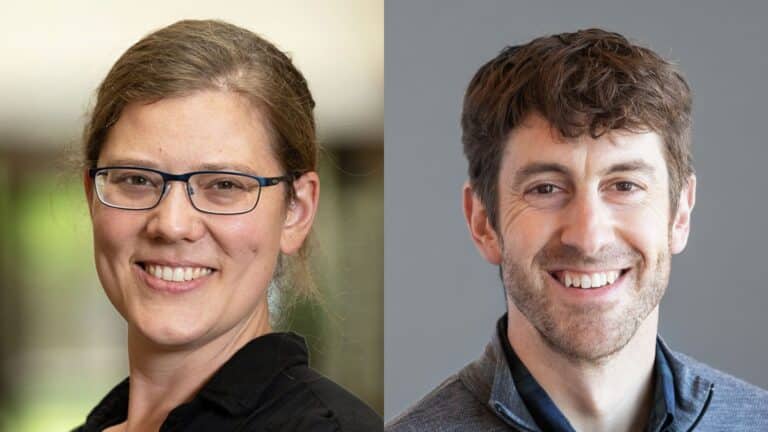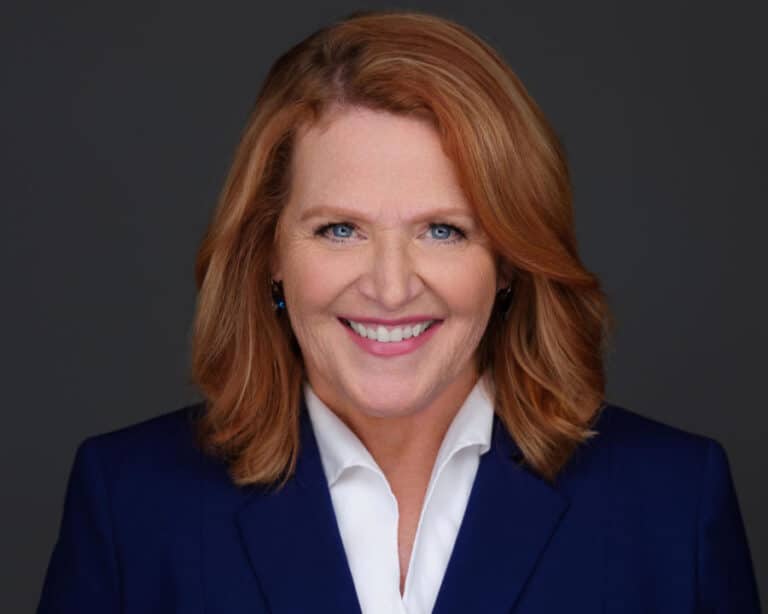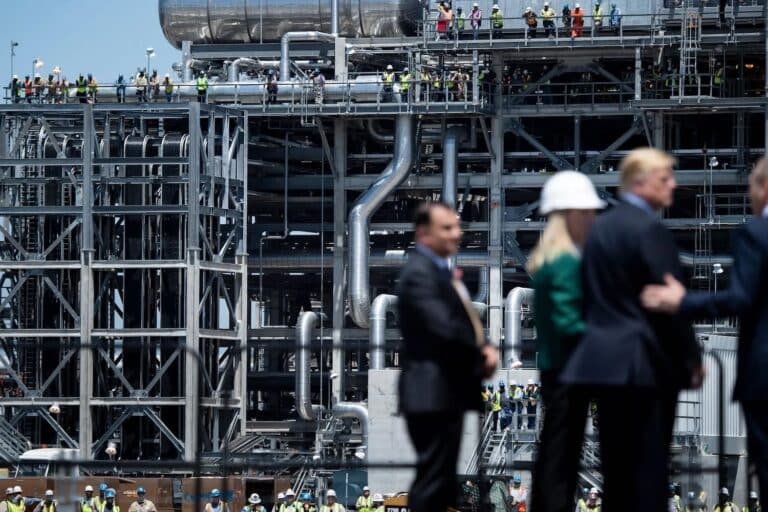This website uses cookies as well as similar tools and technologies to understand visitors’ experiences. By continuing to use this website, you consent to Columbia University’s usage of cookies and similar technologies, in accordance with the Columbia University Website Cookie Notice.
Guest
Michael Gerrard and Jeff Holmstead
Founder, Columbia’s Sabin Center for Climate Change Law; Partner and Co-chair, Environmental Strategies Group at Bracewell LLP
-
Transcript
-
Jeff Holmstead: Initially, it tended to be conservatives that were supportive of the Chevron deference. And I think over time that has switched, especially as agencies, at least in the eyes of many beholders, took evermore aggressive interpretations hoping that the courts would basically defer to their interpretations of the statute.
Bill Loveless: On June 28th, 2024, the Supreme Court overturned a 40-year precedent established in the landmark 1984 case, Chevron versus Natural Resources Defense Counsel. The precedent commonly referred to as the Chevron doctrine, gave federal agencies considerable discretion to interpret laws passed by Congress when implementing regulations and policy. But with the court’s new ruling, federal agencies no longer have the final say on how laws are interpreted. Instead, the judiciary will hold that power. How will the new ruling impact energy policy and environmental regulation? What are both proponents and opponents saying about the court’s decision? And what does this mean more broadly for the modern administrative state? This is Columbia Energy Exchange, a weekly podcast from the Center on Global Energy Policy at Columbia University. I’m Bill Loveless.
Today on the show, Michael Gerrard and Jeff Holmstead. Michael is the founder and faculty director of Columbia’s Saban Center for Climate Change Law. From 2012 to 2018, he was the chair of the faculty of Columbia University’s Earth Institute. Before joining Columbia in 2009, Michael practiced environmental law in New York for three decades. Jeff is a partner at Bracewell, where he heads the Environmental Strategies Group. From 2001 to 2005, he served as the assistant administrator of the US Environmental Protection Agency for air and radiation. During his tenure, he was the architect of several initiatives including the Clean Air Interstate rule, the Clean Air Diesel Rule, and the Mercury Rule for power plants. Michael and Jeff joined me to discuss the implications of the Supreme Court’s decision to overturn the Chevron doctrine. We talked about the court’s original decision in the 1984 case and the purpose its served. We also examined potential signals the decision sends to future administrations and regulators. I hope you enjoy our conversation. Michael Gerrard, Jeff Holmstead, welcome back to Columbia Energy Exchange.
Jeff Holmstead: Thanks.
Michael Gerrard: Thank you for having us.
Bill Loveless: Well, this has been clearly an important legal decision by the high court in the United States, one that has serious implications for regulatory policy in the United States, and one that has been anticipated to some extent by various parties. But let’s just start making sure everyone has an basic understanding of what is this Chevron doctrine, Michael, and why has it been considered to be so important?
Michael Gerrard: The Chevron doctrine arose 40 years ago in a case where NRDC was unhappy with an EPA interpretation of one section of the Clean Air Act, and the Supreme Court announced a rule where if a statute is unambiguous, if the text is clear, that’s what governs. But if the statute is ambiguous, the courts will defer to the way that the administrative agencies interpret that statute. In the Chevron case, NRDC lost and EPAs interpretation governed. And so in the 40 years since then, the case has been cited more than any other case in the history of administrative law, and it’s been the standard understanding that an agency’s interpretation of an ambiguous statute is what governs.
Bill Loveless: Jeff, it’s one that, because you had quite a bit of familiarity with it, correct, from when you were in the EPA during the Bush administration. It’s had quite an impact for some years now.
Jeff Holmstead: Yes, it certainly has. And I will freely confess that when I was at EPA, it was often a topic of conversation. When we were dealing with an issue and we were doing something that maybe was novel and hadn’t been done before, there was a question of whether we had an interpretation that would be entitled to deference under Chevron. It has certainly impacted the way courts review regulations for 40 years. And I think also the way agencies develop regulations as they anticipate getting deference from courts on their interpretation of statutes.
Bill Loveless: Why did the Supreme Court throw out the Chevron doctrine some 40 years after its inception, Michael?
Michael Gerrard: Well, on June 28th, the Supreme Court issued the decision in a case called Loper Bright Enterprises versus Raimondo, which considered in itself a very small issue concerning whether the owners of fishing boats needed to pay for the inspectors who were on their boats. But the court felt that it was really usurping the role of the courts to have agencies decide the interpretation of statutes. The Supreme Court said that it’s really the sole job of the courts to interpret the meaning of statutes, and instead the court should pay attention to the way the agencies consider it, particularly if the agency set forth in a lot of detail why it had a particular interpretation, but that would no longer be binding on the courts.
Bill Loveless: And Jeff, you’ve been looking at this case, this decision very closely. What impressions do you have from it?
Jeff Holmstead: I suspect Michael and I share many of the same impressions. The whole question of Chevron deference has been very much the subject of academic debate for many years. Initially, it tended to be conservatives that were supportive of the Chevron deference, and I think over time that has switched, especially as agencies, at least in the eyes of many beholders, took ever more aggressive interpretations hoping that the courts would basically defer to their interpretations of the statute. It’s certainly been debated for many, many years. I think this decision wasn’t altogether surprising. I think a lot of us expected it, but it is groundbreaking nevertheless. Probably the most important administrative law decision we’ve had since 1984 when the Chevron doctrine was adopted. Although, I mean, I’ll be interested in Michael’s perspective too, but when Supreme Court first announced the doctrine, it’s pretty clear that none of the justices viewed it as a landmark case that really changed much of anything.
There’s an interesting book about the, well, interesting to a few of us about the history of the Chevron doctrine, and there was only six justices. There was really very little debate or discussion about the opinion. And after it was adopted, the Supreme Court took a number of other cases where the question was how agencies had interpreted the statutes, and they actually didn’t cite to or use the approach that had been announced in Chevron. But the DC Circuit took it up and treated it as a landmark decision, and it became, as Michael said, the most influential decision in administrative law cited more than any other case.
Michael Gerrard: And in the days since the Loper Bright decision was issued, there’s been a very vigorous exchange on the environmental law professors listserv and the administrative law professors listserv about just what it means. And there are some who say, well, although the Chevron doctrine has been on the books for decades, it wasn’t always followed, and there were any number of cases where the courts, despite the Chevron doctrine, did not actually defer to the judgment of the administrative agency. There’s another weaker deference called Skidmore deference, and that seemed to be along the lines of what the court is now adopting. That agency’s interpretation is taken seriously, but it’s not binding. There’s a lot of back and forth about is this really as momentous as some have made it out to be? There are a number of other recent Supreme Court decisions that are also extremely important in terms of how the courts regard what agencies do, and we should talk about those as well.
Bill Loveless: Yeah, I’d like to get to that for sure, Michael. What I found interesting here was the discussion in the opinion by the Chief Justice Roberts. He brought up the Mobery v Madison decision, that landmark decision back in 1803 to assert that it is emphatically the province and duty of the judicial department to say what the law is. He went pretty far back in history to justify this decision, didn’t he, Jeff?
Jeff Holmstead: Well, for people who enjoy the history of administrative law, there’s a lot to love about both really, all of the opinions, even though there are constitutional overtones here, the majority opinion focused much more on the Administrative Procedure Act, which was adopted in, what was it, in ’48?
Bill Loveless: 1946.
Jeff Holmstead: ’46. Which also says that it’s up to the courts to decide questions of law even though the agencies get deference on findings of fact. There’s most constitutional overtones, but it was pretty squarely decided, I think, under the Administrative Procedure Act.
Bill Loveless: This was seen by some too as a blow to modern administrative state in the United States, an error which dates back to the New Deal during Franklin Roosevelt’s presidency. Of course, as you note Jeff, it was in ’46 Congress enacted the Administrative Procedure Act to better govern the implementation of laws. But there was a whole trend in the United States regarding administrative law that did go back to Roosevelt and the New Deal. Is it overstating the situation to say that maybe this is bringing to the end and era of the administrative state in this country?
Michael Gerrard: I think it is a great overstatement to say that. We still have agencies, they still issue regulations. They still do many, many things. In a sense, there were a couple of other very recent decisions that maybe even greater blows to the administrative state. The administrative state is still around, but there was a decision issued the day before the Loper Bright case called Securities and Exchange Commission versus Jarkesy that said that before an agency is imposing civil penalties on people for certain violations, they’re entitled to a jury trial. The SEC has for many years had administrative law judges who hear these cases and decide them. And so one big question that has not been resolved is how broad is the operation of the Jarkesy decision? It’s clearly going to completely disrupt the operations of the SEC and make it much harder for them to enforce the securities laws. But EPA has something called the Environmental Appeals Board and their loss of other agencies that have their own adjudicatory processes. And there’s a big open question about is Jarkesy also going to affect those or does it only apply to enforcement of traditional common law violations like fraud as opposed to recent regulatory violations? That’s one very important decision that just came out.
Bill Loveless: Yeah, I mean, this is not the first setback for environmental regulation by this court. I mean, just a couple of years ago, for example, the court limited EPAs authority to regulate carbon emissions from power plants, but that decision relied on a basis other than the Chevron decision, right? In that case, the court relied on the so-called Major Questions doctrine.
Michael Gerrard: Right. Well, first of all, in 2016, the Supreme Court halted the Clean Power Plan without any explanation. They just stopped it until the case had been fully adjudicated. And then, as you say, in 2022, they issued the West Virginia versus EPA decision saying that the Clean Power Plan was invalid, although by then, president Biden was in office, and EPA was saying it wasn’t going to reinstate the Clean Power Plan anyway. But what the Major Questions doctrine does is it say even if the text of a statute might allow something, if what you’re doing is you’re regulating something of great economic importance, and Congress hasn’t been really, really specific in authorizing the agency to do a particular thing, it can be thrown out. EPAs efforts to restrict greenhouse gas emissions from power plants was restricted. The Supreme Court used the same doctrine to throw out a rule from OSHA that gave employers during the height of the COVID pandemic the option of either requiring employees to get vaccinated or to take frequent tests.
And the major questions doctrine is being brought up in many, many other cases. It’s a lead claim in the challenges to the Securities and Exchange Commission Climate Disclosure rules, and it’s being brought up in a lot of other cases, and it’s almost malpractice for a lawyer not to raise a major questions argument in challenging regulation. One of the big problems is nobody really knows the scope of it. Nobody knows how broadly it’s going to be applied and creating a lot of uncertainty in the agencies. I think the uncertainty is one reason why the SEC narrowed down its climate disclosure regulation between the draft from two years ago and the final. In many ways, the Major Questions doctrine could be seen as even a greater blow to the administrative state than the revocation of the Chevron doctrine.
Bill Loveless: Yeah. Jeff?
Jeff Holmstead: I do want to just, I think, correct one thing that you said, and that many people have said is that somehow the West Virginia versus EPA case limited EPAs authority, what it did was say EPA had exceeded its authority. And that’s actually maybe a sound like a distinction without a difference, but I think it is important. If an agency goes beyond what Congress intended it to do, it’s the job of the courts to say you’ve exceeded your authority. It’s been interesting to me, and certainly we haven’t even talked about a couple of other important cases, the Ohio versus EPA case and then the Coroner Post cases as well. I think it’s a mistake to see all of these cases without considering the broader context. I think we’re seeing all these cases as we see agencies being more aggressive in trying to use their existing statutes to deal with perhaps new issues.
I think a lot of what we are hearing from the courts is problematic for the hold of government approach that the Biden administration has taken with respect to climate change. And I think what that was supposed to mean is that every agency of the federal government was supposed to look at what they could do to address climate change. And what that means is they’re looking at statutes that really were not intended to give them that authority. And so the idea that you have many, many different government agencies who can use existing statutory authority to deal with a problem, I think is problematic. And I think that’s where the SEC may run into problems and the new FAR regulations, of course, those remain to be seen. It’s not just the courts pushing back. I think it’s agencies who have been trying to expand the scope of their regulatory authority.
Michael Gerrard: I think that’s a good demonstration of where we differ. It was my view that the Clean Power Plan was within EPAs authority, and the court cut it back. Jeff’s view is that it went beyond the EPAs authority and the court restricted it to what it was allowed to do. And that then gets to partly the issue of whether you really are a textualist, whether you believe it just following the words of the statute. The majority opinion in the West Virginia Case acknowledged that maybe you could read the statute to allow something like the Clean Power Plan, but we think nonetheless, that EPA went too far. Justice Kagan in her dissent said, well, I thought we were textualists, but maybe we’re a textualist only when it’s convenient. Similar situation with the SEC, the securities laws of 1933 and 1934 by their text allow the SEC to require disclosure of things that are financially material to companies.
And the SEC concluded that a lot of climate change issues are. Clearly in 1933 and 1934, Congress wasn’t thinking about climate change. In lots of these statutes they weren’t thinking about climate change, but the wording of the statute set forth the objectives. And there’s a good textualist argument that the agencies should be able to take this action, just like the Occupational Safety and Health Act by its wording would seem to allow addressing COVID as a workplace hazard. But the Supreme Court has decided that a lot of this is going too far, that the mere text is not enough, that you need to look at other factors including the economic significance of an action.
Bill Loveless: What will this court’s decision in Chevron, as well as its reliance on this Major Questions doctrine, mean for new rules at EPA involving power plant and vehicle emissions and methane emissions from oil and gas operations? Are they necessarily doomed now?
Michael Gerrard: Well, it depends on what they are. I think that it’s going to require the agencies to possibly take a narrower view of their authority as the SEC did in narrowing its regulations. We don’t really know yet, but I think it will have an inhibiting effect on agencies trying to be innovative in addressing new problems.
Bill Loveless: Yeah, Jeff, I mean, presumably EPA in propagating these new emissions rules anticipated that the Chevron doctrine might go out the window and adjusted the rules to take that into consideration, right?
Jeff Holmstead: Certainly they must have known that the idea of Chevron deference was problematic, and they did not explicitly rely on it in trying to justify any of their recent rules. My own view is, and I’m most familiar with the power plant rule, I think whether or not Chevron was overturned, that was going to run into legal problems. And we can certainly get into that if you would like. I do agree with Michael that over time, I think it will make agencies more circumspect. Again, I’ve been thinking about this from my time at EPA and what I would say is that President George W. Bush had announced a policy of wanting to have what he famously called the 4P bill because it would’ve originally included CO2 as well as SO2 and NOx and Mercury. But the idea was to have cap and trade programs for all of those pollutants.
And then shortly after he took office, after there was a lot of political pushback on the idea of including CO2, we began to develop and to promote what we thought was a very sensible program that would create cap and trade programs for SO2 and NOx and Mercury. We came very close to getting that, but fell one vote short in the Senate EPW committee. And then we began to say, well, gee, here’s what the policy is. Here’s the regulatory program. Can we do it under the existing Clean Air Act? And so we took a fairly innovative interpretation of, again, section 111, expecting that we might get Chevron deference. I bring that up as an example because I think in some ways it’s a little backwards. You have an administration that comes in with something they want to accomplish, and they try to fit the words of the statute to support what they want to do as opposed to saying, what is it that Congress authorized and intended us to do under the statute and implementing it? I do think over time it will inhibit the activities of regulators, and I have some hope that it will also lead to more debate and discussion and compromise in Congress.
Bill Loveless: That may be a big ask, right? I mean, just given that Congress in recent years has been unable to pass significant legislation on a bipartisan basis, right? In the absence of that, we see agencies try to fill the gap and rely on their interpretation and their expertise, but now the court says that’s not possible. It does seem as though it may stop dead in its tracks efforts by, say, a Biden administration to continue to take the route it’s taken to enact regulations. Now, if it was a Republican administration in place, it may certainly may have an impact. I’m sure it would have an impact on EPA under that authority as well.
Michael Gerrard: All the major federal environmental statutes were enacted between 1969 and 1990. Since 1990, there hasn’t been a major new environmental statute enacted. There were some big amendments to the Toxic Substances Control Act and some other amendments to the National Environmental Policy Act and NEPA and the Fiscal Responsibility Act. But we don’t have any new statutes since 1990, and there’s no word when we will get any major new statutes. It’s really a problem for EPA in dealing with what are really new problems and being stuck with these old statutes. If the question is, did Congress in 1990 intend to regulate greenhouse gases and allow all these other things? Probably not, although there was information before Congress on greenhouse gases in 1990. But if we’re going to deal with these new emerging problems, whether it’s EPA and greenhouse gases, or OSHA and COVID or lots of other problems, the administrative agencies need some flexibility.
And I think it’s a real problem when the courts are saying, no, you’re really stuck with these old laws, and especially when they start going back to the era of muskets interpreting the Constitution. It’s really sticking us. And in my own view and the view of a lot of people, this is really a power grab by the Supreme Court that the Supreme Court is saying that it’s limiting the ability of agencies to act. It’s saying that they’re not even going to rely completely on the text of what Congress does, that the Supreme Court is the final arbiter of so many things and reducing the power of EPA and other agencies of the administration to act and to a certain extent of Congress to act. I think it really causes a lot of difficulties.
Bill Loveless: Well, I mean, the court has in the past stepped in and clarified what the law said, and to the extent that people sought admissions regulations, they were pleased in thinking of the Supreme Court’s 2007 decision in Massachusetts versus EPA that conclusively established that greenhouse gases qualify as air pollutants under the Clean Air Act. Plus that was a different court and different circumstances.
Michael Gerrard: It was a five to four decision, and none of the five are still on the court. The Massachusetts versus EPA decision was regarded as an environmental triumph near as it was. But in the more recent years with the changing composition of the court, that’s not the decision we’re seeing anymore.
Bill Loveless: Yeah. And legal precedents can be turned as we’ve seen in recent years, right, Jeff? This court has not been reluctant to reverse longstanding legal precedents. I mean, could a decision like this one in Massachusetts versus EPA be at stake?
Jeff Holmstead: I don’t think there’s any risk of them revisiting the Massachusetts versus EPA decision for a variety of reasons. I think that’s pretty well established. I would certainly be surprised if they were to revisit that. And various people have tried to get that back before the court, and there’s been no takers so far.
Michael Gerrard: Yeah, that would be very tough. That part of Massachusetts versus the EPA that said that carbon dioxide and other greenhouse gases could be pollutants that are regulated and the Fiscal Responsibility Act of a couple of years ago explicitly put greenhouse gases into the Clean Air Act. There’s another aspect of the Massachusetts case on the standing of states to sue. There is some question about that, and that might be reduced, but for our purposes, I don’t think that they’re going to take greenhouse gases out of the Clean Air Act. But obviously, as you said, Bill, this court has been reversing long-established precedents far and wide. The most famous obviously is the Dobbs case reversing Roe v. Wade. But the Loper Bright decision undoing the Chevron case is also very high on the list.
Bill Loveless: Is it reasonable to assume that Congress sometimes leaves statutes somewhat and deliberately ambiguous because it wants to defer to agency expertise?
Michael Gerrard: Yeah, I think partly because they want to defer to expertise or they just want to dodge hard problems. Sometimes they just can’t reach a consensus and they leave it open and hope that and rely on the agencies to resolve it. Some have said that since the Loper Bright case and various other things, maybe Congress will get back to work and start passing laws, but I think that requires a certain degree of partisan agreement that we’re not seeing these days.
Bill Loveless: It’s a question, what sort of signal, Jeff, does this send to Capitol Hill? Or is it a signal that, as Michael suggests, the political leaders on the hill, both parties are simply not in a position to really address squarely?
Jeff Holmstead: I certainly don’t disagree that the polarization in Congress has made it very difficult to pass meaningful legislation in many areas. But I actually think that Chevron has contributed to that. I was involved in a situation where back when I was advising the Mitt Romney campaign, and there was a lot of discussion about the possibility of a cap and trade program or even a carbon tax. And in a round table discussion, I made the point that I thought a lot of people in industry would be supportive of that as long as it was clear that that would then be the program for regulating CO2, that it wouldn’t also be regulated under the Clean Air Act. And I thought that was an obvious point, but there were senior officials in Democratic administrations who said, no, no, no, no, we’ll never give up our authority to CO2 under the Clean Air Act. That’s completely off the table. That’s a non-starter. And I think as long as people believe they can accomplish their objectives under current law, it makes them much less willing to make the compromises that you need to make to pass legislation. I do think Chevron has actually played a part in contributing to the polarization and the lack of the ability to get anything done because there’s no compromise on either side.
Michael Gerrard: Let me just say that I think the significance of the revocation of the Chevron doctrine took on greater significance a couple of days later with the Supreme Court’s decision, and another case that Jeff alluded to, the Coroner Post versus Board of Governor’s case. And that was a decision that basically said that even though there’s ordinarily a statute of limitations for challenging administrative action, companies or anybody adversely affected by a regulation can sue many years later, if only then are they subjected to requirements or enforcement under that. And so that means that even if you have a regulation that’s 20 or 30 years old, and it would seem to be way too late to challenge it in court, now under this Coroner Post decision, you can if you’re a company that is newly subject to enforcement. And that I think is an invitation to a lot of companies to start bringing lawsuits against the agencies challenging all kinds of regulations.
I think we’re going to see a raft of this litigation against lots and lots of old, well-established regulations on the grounds that maybe they were approved under the Chevron doctrine and that’s gone. Or maybe the Major Questions doctrine now means they’re not any good or various other grounds to challenge them. I think that too destabilizes the administrative state to a certain extent. Time will tell, but I think that it’s very likely, and I can already envision the big law firms that are suffering through lots of regulations and figuring out what would be useful to challenge.
Jeff Holmstead: I agree with Michael that that could ultimately be just as important as the Loper Bright decision. On the other hand, in the arenas in which I operate, which tend to be primarily in the Clean Air Act, there have been at least two Republican administrations who upon taking office made an invitation to say to industry, tell us what are the regulations that are most problematic that you would like us to revisit? And they got very little input. I mean, other than complaints about the new Source Review program, which is ongoing, for the most part, major companies, industry in general has come into compliance and they don’t necessarily want to have that undone for a variety of reasons. I certainly have seen the predictions about a flood of litigation. I don’t discount them completely, but I think we have to wait and see what will happen. Of course, when statutes like the Clean Air Act have their own deadlines for challenging, then that supersedes the EPA statute of limitations that was an issue in Coroner Post. It really doesn’t have any impact on any major Clean Air Act regulations because by statute, they can only be challenged within 60 days of when they’re promulgated.
Michael Gerrard: One of the interesting phenomenon we’re seeing is that often it’s not the industry that is directly regulated that is challenging a rule. The largest source of greenhouse gas emissions today in the United States is motor vehicle emissions. And there are a lot of lawsuits that are pending against EPA for some of its recent regulations on motor vehicle emissions. But a lot of these lawsuits are coming not from the motor vehicle manufacturers, but from the red states and from the oil industry. The red states don’t like them ideologically, and the oil industry realizes that improved fuel economy and a move to luxury vehicles is a threat to the demand for their product. It’s not primarily the motor vehicle manufacturers, the directly regulated industries that are challenging these roles.
Jeff Holmstead: Yeah. But they may run into standing problems in those cases, I think, Will. There’s some indication that’s already happening, but we’ll see how that plays out in the coming years.
Bill Loveless: We’ve talked about how this decision on Chevron would likely inhibit an administration from attempting to be active in promulgating regulations for emissions as well as other issues across the government. But Jeff, what if Donald Trump is elected and how might an administration like his take the Chevron decision into consideration to implement its agenda?
Jeff Holmstead: I actually think it will be constraining on a Trump administration too. There may very well be deregulatory ideas that they would like to pursue, hoping that their new interpretation would get some deference under Chevron. One of the things that the justices mentioned in looking at Chevron was the fact that the law can remain unsettled. Because if the idea is there are multiple permissible interpretations, a new administration takes office and they say, well, the court’s upheld a prior permissible interpretation, but we now have our new interpretation that’s also permissible. And the court has said, no, that’s not the way the law is supposed to work, it’s supposed to be based on the best meaning. And so I can imagine some things that a Trump administration might like to do, but would run into trouble without being able to rely on deference under Chevron. It certainly will cut both ways.
Michael Gerrard: Can I mention another decision that I think is going to inhibit regulatory action? And it’s one Jeff also alluded to, the Ohio versus EPA, which was decided on June 27. And that is a case under something called the Good Neighbor Rule, mostly for controlling nitrogen oxide emissions. And EPA has been trying to control those since 1998, since an old rule called the NOx SIP call. But there’s been litigation going back 26 years over the efforts to control that pollutant, which increases unhealthy ozone. And then there was a Supreme Court decision called the Homer City case in 2014, and it’s a very long process under which EPA has been trying to control this pollutant. But in the Ohio versus EPA case, the Supreme Court threw out a particular action by EPA because the Supreme Court found that the EPA had not adequately responded to one of the comments that was made on the draft regulation.
Justice Barrett, who is not usually on the environmental side in these cases, issued a very strong dissent going through this in enormous detail and saying that this was one comment out of hundreds or thousands of them, and they had responded just not in a lot of detail. But what I’m afraid Ohio versus EPA is going to do is make it much harder for regulations to be enacted. Because when an agency is getting thousands of comments on a regulation, which they do on the complicated things, and they have to write a very detailed response to every one of them. That’s going to make it really hard for them to just finish the process, it’s going to take forever. It’s really going to bog down and it’s going to be a major problem.
Jeff Holmstead: I think it’s a bit of an exaggeration to say that there are thousands of comments. There are sometimes thousands or millions of comment letters, but the agency doesn’t have to respond to every comment submittal. It has to respond to all the issues that are raised. And typically in these regulations, there are a pretty limited number of substantive issues that people are commenting on, even though you may have thousands of comments on that issue. I do think Ohio v EPA will be an important decision, but maybe not for the reasons that Michael suggests. Since 2011, since the DC circuit actually stayed any EPA regulation, and the Supreme Court has now stepped in twice and basically said that the DC circuit got it wrong. That if there is a regulation that is going to require companies to spend hundreds of millions of dollars before they can have their day in court, courts should take seriously their responsibility to consider whether they should let that go into place or whether they should finish a litigation before deciding that people have to make those kinds of investments.
I view that as a pretty clear signal to the DC circuit that they need to take that responsibility more seriously. And in my own mind, I think that is partly due to what we saw in the MATS case where by the time the MATS rule got to the Supreme Court, every single coal-fired power plant in the country had either come into compliance or shut down. And when EPA lost that case from the Supreme Court, the administrator famously reassured her supporters that it didn’t really matter because it had already done what it accomplished, and it didn’t matter what the Supreme Court said. And I think those comments have certainly been cited back to the courts who’ve said, you shouldn’t let this happen if EPA makes a stretch, and that’s going to cause that immediate impact on people before the courts can decide. The courts need to step in and put it on hold, and I think that’s what they did in Ohio v EPA.
Bill Loveless: Well, there’s so many implications for these various decisions, the big ones like Chevron, but others too, which have a lot of significance that we will be continuing to watch closely. Hey, before we go, I wanted to ask you, Michael and Jeff, what have been some of the trends in climate change litigation in the United States and around the world? I mean, it’s a big topic. I know we could have a whole podcast just on that, but I mean, just generally speaking, there seems to be a whole lot of things going on legally regarding climate change in the United States and in courts around the world.
Jeff Holmstead: Can I just step in and say, Michael is probably the foremost expert in the whole world on this topic. I think he and his organization tracks these better than anyone else. I rely pretty heavily on his website when I’m trying to figure out what’s going on in all these cases around the country and around the world. With that introduction, Michael, I’ll let you give us a brief summary of the thousands of cases that are being litigated.
Michael Gerrard: Thanks so much. We do maintain a database that tries to capture all the climate litigation in the world. There are something like 2,800 cases now on our database. Of them, about 70% are from the US. The US is by far the champion. We’ve seen quite a few decisions globally outside the US using human rights theories and related theories to find that governments need to do more to fight climate change. And we have important recent decisions from the European Court of Human Rights and the International Tribunal on the Law of the Sea on that. We’re waiting for decisions from the Inter-American Court of Human Rights and the International Court of Justice, but several domestic courts have come out that way. The US has not joined the human rights treaties that are the basis for many of these other decisions. There are decisions from Montana and Hawaii, both of which have environmental rights provisions in their constitutions, but a lot of the most prominent, not numerically high, but prominent litigation in the US has been, there are about 25 lawsuits now pending brought by states and cities and counties against the fossil fuel companies for money damages, for the money to prepare for climate change.
All of those have been held up for years on various procedural issues. The Hawaii Supreme Court recently ruled in a case brought by Honolulu that the case could go forward. The fossil fuel companies are asking the Supreme Court to take the case. We’ll see what happens with that, and if the Supreme Court does take that case, I think that many of these cases are going to be put on hold until they decide. If they don’t take the case, I think that some of them will roar forward possibly toward trial. We’ll know in a few months what direction those are going in.
Bill Loveless: Well, as we say, there’s a whole lot there. We could have another whole podcast on this, and that’s something we certainly need to do in the future. But Michael Gerrard, Jeff Holmstead, thanks for taking the time to help us understand this important court decision on Chevron today, as well as these other various legal implications and doing so with us on Columbia Energy Exchange. Thanks a lot.
Michael Gerrard: Thank you.
Jeff Holmstead: It’s been a pleasure.
Bill Loveless: That’s it for this week’s episode of Columbia Energy Exchange. Thank you again, Michael Gerrard and Jeff Holmstead, and thank you for listening. The show is brought to you by the Center on Global Energy Policy at Columbia University School of International and Public Affairs. The show is hosted by Jason Bordoff and me, Bill Loveless. The show is produced by Erin Hardick from Latitude Studios. Additional support from Lily Lee, Caroline Pittman, and Kyu Lee. Roy Campanella is the Sound Engineer. For more information about the show or the Center on Global Energy Policy, visit us online at energypolicy.columbia.edu or follow us on social media, @ColumbiaUEnergy. If you like this episode, leave us a rating on Spotify or Apple Podcasts. You can also share it with a friend or colleague to help us reach more listeners like yourself. Either way, we appreciate your support. Thanks again for listening. See you next week.
On June 28, 2024, the U.S. Supreme Court overturned a 40-year precedent established in the landmark 1984 case, Chevron v. Natural Resources Defense Council.
The precedent, commonly referred to as the “Chevron Doctrine,” gave federal agencies considerable discretion to interpret laws passed by Congress when implementing regulations and policy. But with the court’s new ruling, federal agencies no longer have the final say on how laws are interpreted. Instead, the judiciary will hold that power.
So, how will the new ruling impact energy policy and environmental regulation? What are both proponents and opponents saying about the court’s decision? And what does this mean more broadly for the modern administrative state?
This week host Bill Loveless talks with Michael Gerrard and Jeff Holmstead about the implications of the Supreme Court’s decision to overturn the Chevron Doctrine.
Michael is the founder and faculty director of Columbia’s Sabin Center for Climate Change Law. From 2012 to 2018, he was the chair of the faculty of Columbia University’s Earth Institute. Before joining Columbia in 2009, Michael practiced environmental law in New York for three decades.
Jeff is a partner and co-chair of the Environmental Strategies Group at Bracewell LLP. From 2001 to 2005, he served as the assistant administrator for air and radiation in the U.S. Environmental Protection Agency.
More Episodes
Trade War Turbulence and Clean Energy
It’s hard to overstate how consequential President Trump’s “Liberation Day” tariffs have been for American economic policy. While the administration has paused the steep reciprocal tariffs it announced...

Front Lines of the Energy Transition
In energy policy circles, the word “resilience” often refers to future-proof systems or infrastructure designed for the transition away from fossil fuels. But resilience means something different to...

Europe’s Energy Trilemma
The European Union’s energy landscape is transforming rapidly, as the bloc works to reduce emissions, lower energy prices, and decrease dependence on Russian fuel—three goals proving to be...

Breaking America’s Energy Policy Gridlock
Across America, energy policy is often driven by short-term politics over long-term planning. Despite record-breaking U.S. oil production in recent years, partisan battles continue over fossil fuels and...

Relevant
Publications
Q&A: Trump’s Executive Order on US Domestic Mineral Production
This Energy Explained post represents the research and views of the author. It does not necessarily represent the views of the Center on Global Energy Policy. The piece...

Energy and Climate Issues During the Trump Administration’s First 100 Days
President Donald Trump has made energy a clear focus for his second term in the White House. Having campaigned on an “America First” platform that highlighted domestic fossil-fuel growth, the reversal of climate policies and clean energy incentives advanced by the Biden administration, and substantial tariffs on key US trading partners, he declared an “energy emergency” on his first day in office.

The U.S. Should Not Politicize LNG Exports
Can U.S. gas exports throw a lifeline to Europe without raising prices at home?

More energy is more security
The incoming Trump administration should embrace a diverse energy mix, including renewables, for the sake of economic and national security.


